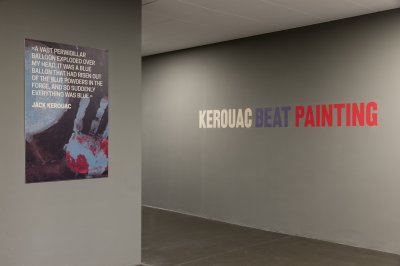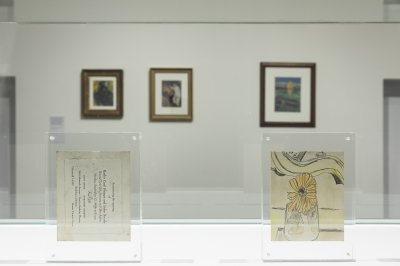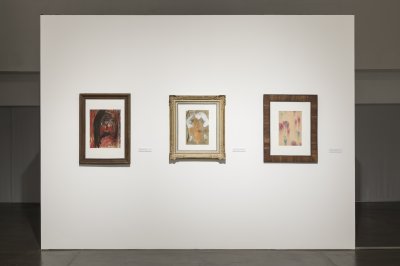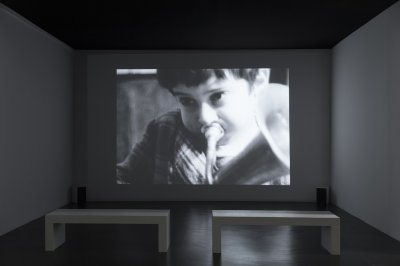Kerouac. Beat Painting
 03 December 2017–22 April 2018
03 December 2017–22 April 2018
The Exhibition
In a first for Italy, the exhibition Kerouac. Beat Painting and the catalog accom- panying it present a series of never-before-seen artworks, images and stud- ies representing the visual art of Jack Kerouac, one of the twentieth-century’s greatest writers and one of the founders of the Beat Generation, the literary and artistic movement that scandalized the Puritan mentality of the United States, and shocked Europe as well, starting in the late 1940s.
This exhibition is part of the museum’s broader agenda concerning its ex- hibitions and the research behind them: on the one hand, it aims to foster the exploration of unfamiliar aspects of contemporary visual culture; on the other hand, it seeks to describe the evocative interactions between different fields of artistic expression, specifically the crossover between painting and literature. Thus under- stood, Kerouac. Beat Painting picks up where Ritmo sopra a tutto left off. The 2016 exhibition curated by Franco Buffoni, in fact, examined the relationship between art and poetry in Italian culture in the second half of the twentieth century.
The nearly one hundred works by Kerouac on display, dating to the late 1950s and early 1960s, include pieces of paper of different sizes containing both drawings and paintings; the film Pull My Daisy (Robert Frank and Alfred Leslie, 1959), written by and starring Kerouac; and the well-known TV interview conducted by critic and translator Fernanda Pivano, as well as excerpts from Kerouac’s writings and some of his personal effects, all rounded out by a thor- ough critical apparatus.1
We make no pretense of faithfully reconstructing Kerouac’s complex career as an artist, since our chief concern is to provide an original interpretation of this major writer/artist, one that shows Kerouac in a new light, with his writings, paintings, drawings, scripts and his own voice all placed in a single, impetuous creative flow that admits no barriers, obstacles or classifications. The works on display, therefore, should not be approached using an art critic’s traditional methods, but seen with one’s eye and one’s mind, the two tools capable of perceiving the powerful world of Kerouac’s art. After all, Kerouac felt the need to convey his ideas and feelings through an array of tools and visions, seeing artistic expression in its totality.
His drawings and paintings complement and round out his writings, show- ing the latter from a whole new angle that is stimulating and vital.
As further proof of the potency of Kerouac’s art, the exhibition opens with a tribute by another great artist, Peter Greenaway, the director and screenwriter, and a highly skilled draughtsman himself. His own drawings are mainly visions and interpretations that project Kerouac into the future, in an energetic burst of fantasy that could well lead to new artworks, new directions and possibly even new films by this auteur filmmaker.
Considering the complexity of this corpus of artworks, the curators de- cided to display and consequently publish the artworks by arranging the sec tions of the exhibition thematically, allowing for a wide-ranging analysis of the connections between Kerouac’s literary works, artistic output and his own life story. These sections are interspersed with essays written for the occasion by experts from different areas, devoted to Kerouac’s own works and, more broad- ly speaking, to the larger question of the relationship between American and European art in the immediate post-WWII period. The first section, “A Personal Album,” brings together a series of portraits Kerouac made of friends and ce- lebrities as well, some of whom he had met and others he had come across in the magazines of his day, particularly Life. Parallel to this section, the opening essay in the catalog by curator Sandrina Bandera, “Jack Kerouac: Surprising Cultural Interactions,” looks at the sources of his art and the importance of the history of European art to his own background as an artist. The exhibition next turns to the film Pull My Daisy by Robert Frank and Alfred Leslie (1959), a free- wheeling improvisation of a scene from a play script by Jack Kerouac that was never performed. Kerouac himself dubs all the characters and comments on their actions as he goes. The film is elucidated by the essay “Is the Word Holy? On Kerouac’s voice in Pull My Daisy” by Enrico Camporesi, who has fresh ideas about Kerouac’s use of voice and improvisation. Another essay in the catalog by critic Francesco Tedeschi is also concerned with improvisation; it leads off the fourth section of the exhibition, “Abstract Expressionism,” featuring works which clearly show the gradual transition from figurative art, albeit freer, yet still recognizable, to the use of improvised and decidedly abstract lines and shapes.
The focal point of the exhibition actually consists of two quite different yet complementary sections, “Visions of Jack” and “Beat Painting,” which explore the dimension of sacredness and other aspects of Beat culture.
In “Visions of Jack,” the artworks, accompanied by an introduction by Ste- fania Benini, reflect the main religious themes, both Catholic and Buddhist, with which Kerouac’s writings and artworks are permeated. These themes become the hallmarks of his graphic art and paintings and include the angel, the Holy Ghost, the cross, Buddha, the dying Christ, Mary Magdalene and so forth, all proof of the complex cultural universe in which the writer was immersed, and his own desire to give shape to a transcendent reality.
The totalizing perception of reality, in which personal plans, interests and models for life overlap to the point of canceling each other out, can be seen most clearly in the section “Beat Painting,” explored in depth in the essays by Franco Buffoni, who looks at the history of Kerouac’s involvement with Italian cul- ture and the culture of his day, and by Virginia Hill, who explains the ties between the Beat Generation – and Kerouac, above all – and fashion and style in general.
The exhibition concludes with a famous interview with Kerouac by Fer- nanda Pivano in 1966, for RAI Television, reproduced courtesy of the RAI Teche Archives, along with a series of photographs by Ettore Sottsass, taken in the same year, when Kerouac came to Italy.
Kerouac’s legacy is alive and well today in our mind’s eye, and not just from a literary point of view, but in the perception of the world and the coming of age of an entire generation inspired and energized, then and now, by Kerouac and the Beat movement.
Three personal accounts published in the catalog bear out the lasting impact of that legacy. The first is a touching interview with sculptor Arnaldo Pomodoro, conducted by Ada Masoero. The artist reminisces about Kerouac and what he meant to the American youth culture during the student protest movement, when a young Pomodoro was teaching at Stanford University in California as an artist-in-residence.
The second is an account by a major collector of Kerouac’s artworks, Ar- minio Sciolli, enamored of the writer and what he represented long before he became his most ardent supporter and collector, along with his brother Paolo.
Lastly, John Shen-Sampas reminds us that these artworks were a gift from Kerouac to his brother-in-law John Sampas.
By the same token, Kerouac’s enduring relevance and his warm following that includes a host of artists, intellectuals, writers and musicians have prompted us to devote an event running parallel to the exhibition, called My Kerouac, reserved for what Kerouac represents today, to both young people and the generation of his own day. This will be an unstructured, freely conceived space for further reflection, where ideas and associations will be conveyed by graphic art, photographs and other visual art, along with performances and writings by anyone interested in adding to the vibrancy of our exhibition: a fluid space that corresponds to the writer’s own creative flow.
We would like to thank everyone who collaborated on this project for the hard work, professionalism and dedication they put into the selection of artworks and other exhibits for the show, particularly those who loaned their own artworks, Arminio and Paolo Sciolli as well as the EFG Art Collection – Swit- zerland, The Museum of Fine Arts – Houston; and the archives of the Corriere della Sera and the RAI Teche. We are also grateful to the experts who brought their own enthusiasm to the project, writing essays that we believe are crucial to the understanding of Kerouac’s literary and artistic output. Besides, we thank the museum’s supporters, Ricola, BIG srl, The Friends of the MA*GA Museum, the Fondazione Cariplo, the Heritage Art Foundation, and Castaldi Lighting, all of whom helped make this exhibition possible, as well as the many educational initiatives connected with it.
Lastly, we’d like to thank the Municipality of Gallarate, MiBACT, the Lom- bardy Region, the Province of Varese, and the founding members of the muse- um, whose participation is vital to the museum’s success. Special thanks go to Andrea Cassani and Isabella Peroni, respectively Mayor and Gallarate Councillor for Culture, as well as Andrea Mascetti, who represents the Fondazione Cariplo, which first put us in touch with the collectors of Kerouac’s artworks. We wish to thank Minister of Culture Dario Franceschini wholeheartedly for choosing to write an essay that was not just “institutional” but “from the writer Franceschini to the writer Kerouac.”




